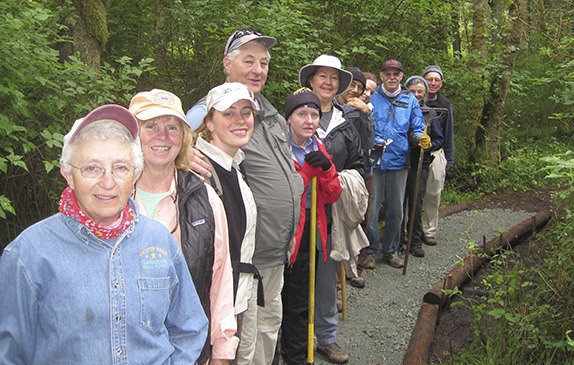By Joan Carter
Special to the Weekly
Every June on Father’s Day, the group shelter at Odlin County Park is abuzz with the arrival of a crew of volunteers. Tents are hastily pitched before an evening shower. Dinner prep engage a few to chop salad and stir spaghetti on camp stoves. Soon, Nick Teague, outdoor recreation planner for the BLM San Juan Islands National Monument, arrives and the hugging begins. Year after year, most of this crew has traveled to Lopez, drawn by the Puget Sound landscape so different from their hometowns in the California Sierra, northern Colorado, Cleveland, Connecticut and Los Angeles. Under the auspices of the American Hiking Society they cross land and sea to embark on a special “vacation,” one of 60 similar work weeks across the country and the first one to reach capacity – often in less than a single day. The San Juan islands are that special.
“Breakfast everyone. Come and get it while it’s hot!” shouts the kitchen team.
Six of the 11 souls have been up since first light; four more roll in, and soon the coffee is gone, then the sausages, then the eggs. The 11th – a first-timer – barely gets the very last bites. The others tease her: “you snooze, you lose,” and she laughs. Soon we’re at the work site with Sara Waugh, assistant park manager at Odlin, at Shark Reef Sanctuary. At the trailhead, a “bucket brigade” forms up to move gravel 500 yards. Two women vigorously shovel the gravel off the park pick-up truck but had to ratchet down their vigor so the other nine crew members could keep up the pace. Our reward for our endeavor was lunch on the bluff overlooking the San Juan Channel. No orcas got the memo about showing up. Another day.
A break in the weather enabled us to head out Tuesday to Lopez Hill with Tim Clark, land steward on Lopez for the San Juan County Land Bank. We didn’t know what to expect when he described deer “exclosures” except that they were the likely cause of the disappearance of trees by their browsing. Nylon fencing was soon rigged up by the efficient crew, fueled by Tim’s signature treats from Holly B’s and attested by veterans of his previous projects. A Wednesday morning at San Juan Island’s Cattle Point Interpretive Center (DNR) and the nearby Cattle Point trail (BLM) for regular maintenance led into an afternoon with Doug McCutcheon of the San Juan County Land Bank at Westside Preserve. His task for the next few hours was 1) to call ahead for the local whales to swim by, and 2) to keep us on task to cut back Himalayan blackberries. No orcas, but an acre of berry bushes bit the dust. Doug’s treat: farm-fresh strawberries! As we reveled in views of the Olympic range in the distance, he was asked about the infamous Pig War of 1859, and about the curious site of rare prairie grasses on the acreage we were working on. Doug was eager to share how the land bank concept is spreading across the U.S., a management scheme for maintaining and protecting both wild and urban landscapes.
We get caught up in the stewardship ethic and almost forget that we’re supposed to be working. Too soon it’s quitting time to get to the ferry – and the day concludes with ice cream at the water’s edge. This small sample of the Northwest is ‘way cool!
Thursday was hard – up at 5 a.m. Grab a bite. Board the 6:45 a.m. ferry. Off to Shaw Island. But when Katie McLane, San Juan County Shaw Island Park manager greets us with a warm smile. Even the grumpiest soon realize: we’re appreciated even before we lift a shovel of dirt! Katie explained she wanted a trail connected in the undergrowth. “Follow the flags! Watch out for slugs! Olive-colored Ariolimax good; black Arion bad!” The crew hums and slices and after two hours, the connection complete, Katie cheers and says “We’re open for hikers this weekend, thanks to you-all!”
As the last work day approaches, we realize what a perfect setting we’re in. Volunteering can’t be this much fun, can it? “Guess so” we conclude, as our State Parks boat speeds over to Patos Island. The Captain, Washington State Parks, San Juan Marine Park Manager Ted Schlund, circles around for the best view of the whitewashed lighthouse and into the harbor and onto the beach. We scatter in three directions to lop foliage beside the trails and clean up the shoreline before joining Keepers of the Patos Light volunteers for lunch. We’re all the same: committed, content, and conservation-minded.
A week’s work behind us, Nick hugs us goodbye before the ferry churns away Saturday morning. Just as with every year since the first AHS crew arrived in 2006, these volunteers are more than reliable; their sweat and smiles will benefit the San Juans again and again and again.



